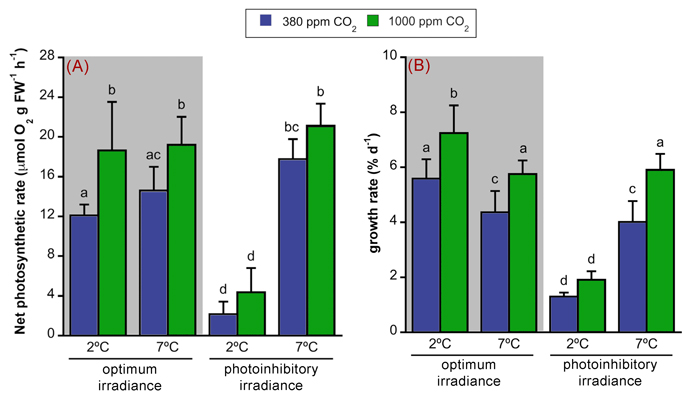| Tweet | Follow @co2science |
Paper Reviewed
Iñiguez, C., Heinrich, S., Harms, L. and Gordillo, F.J.L. 2017. Increased temperature and CO2 alleviate photoinhibition in Desmarestia anceps: from transcriptomics to carbon utilization. Journal of Experimental Botany 68: 3971-3984.
Largefoot desmarestia (Desmarestia anceps), a brown macroalga endemic to the Antarctic environment, was the focus of study in a recent paper by Iñiguez et al. (2017). Concerned about the potential impacts of a changing future climate on this ecologically relevant species, the team of four scientists hailing from Spain and Germany set out to investigate the physiological response of D. anceps to two CO2 levels (380 and 1000 ppm), two temperatures (2 and 7°C) and two irradiance levels (65 and 145 µmol photons m-2 s-1) in a controlled laboratory setting over a period of approximately two weeks.
In discussing the rationale of their treatment conditions, Iñiguez et al. note that largefoot desmarestia typically grows in the mid-sublittoral zone down to depths of ~20 m and exhibits maximal growth rates between 0 and 5°C; and, therefore, they selected temperature treatments of 2 and 7°C to represent normal and elevated growing temperature conditions. With respect to the differing irradiance levels, the 65 and 145 µmol photons m-2 s-1 treatments were chosen to represent optimum and photoinhibitory light levels, respectively. And finally, the two CO2 treatments were selected to represent current (380 ppm) and future (1000 ppm) atmospheric concentrations.
So how did these three variables (temperature, light and CO2) interact to influence the growth of D. anceps?
As illustrated in the figure below, under every possible combination of temperature and irradiance treatment levels, elevated CO2 concentrations at 1000 ppm stimulated both the net photosynthetic (Panel A) and growth (Panel B) rates of this macroalga species compared to those observed under ambient CO2 conditions (380 ppm) between 30 and 50 percent. Given these and other findings reported in their paper, Iñiguez et al. thus conclude that "D. anceps would maintain its productivity in near-future scenarios of increased temperature and CO2 across a wider range of irradiance than under current conditions."

Figure 1. Net photosynthetic rate (Panel A) and growth rate (Panel B) of Desmarestia anceps after/during 12 days of culture at different CO2 levels (380 or 1000 ppm), temperatures (2 or 7 °C) and irradiance conditions (65 µmol photons m-2 s-1 or 145 µmol photons m-2 s-1). Values are mean ± SD (n = 6). Significant differences (P < 0.05) revealed are indicated by different letters. Source: Iñiguez et al. (2017).




